Elliott Waves Theory: Different Types of ZigZags
The Elliott Waves Theory as we know it today appeared in the middle of the 1900’s. Ralph Elliott believed any market moves for a reason, and that reason has to do with crowd behaviour.
Hence, the entire Elliott principle focuses on understanding crowd behavior. And, trading it.
Because of this, the principle applies to any financial market. Wherever there’s the human touch, the Elliott Waves Theory works.
So far, we explained in the Intermediate level of our Trading Academy the types of flats as corrective waves. Moreover, we argued that corrective waves form more often than impulsive ones.
That is correct, with one exception: when the impulsive wave is an integral part of a corrective wave of a bigger degree.
For example, in a flat pattern, only the c-wave is an impulsive wave. Hence, in the flat of a bigger degree, there is one impulsive wave.
Things differ with zigzags. A zigzag is the most deceiving pattern, as the only corrective wave that resembles impulsive activity.
For this reason, most Elliott Waves traders label a zigzag as an impulsive wave. Instead, a zigzag has not one, but two impulsive waves: wave ‘a’ and wave ‘c’ of the pattern.
Here are tips on how to recognize a zigzag:
- A zigzag channels, an impulsive wave doesn’t. Hence, if one uses numbers on a move that channels, that’s incorrect.
- Typically, waves ‘a’ and wave ‘c’ of a zigzag have equal lengths
- The b-wave of a zigzag will fail to retrace more than 61.8% of the previous wave ‘a’
- The c-wave must exceed the end of wave ‘a’
You probably already spotted the main difference between a zigzag and a flat pattern: the b-wave retracement.
Once again, the golden Fibonacci ratio (61.8%) plays a vital role in the Elliott Waves theory. However, there’s a catch: usually, the b-wave is so weak, it barely retraces 23.6%, maximum 38.2% of the previous wave ‘a’.
Hence, if you see a b-wave retracing over 61.8% of the previous wave ‘a’, the entire pattern is most likely labeled incorrectly.
Types of Zigzags in Forex Trading
For a zigzag to form, the market travels in two impulsive waves. It only pauses for a moment to catch its breath, barely correcting for the b-wave, before resuming the initial trend in another five-wave structure.
As a rule of thumb, the minimum retracement level for the b-wave is only 1%. In Forex trading, that’s virtually nothing, so even a horizontal consolidation area, say, in the Asian session, is enough for the b-wave of a zigzag.
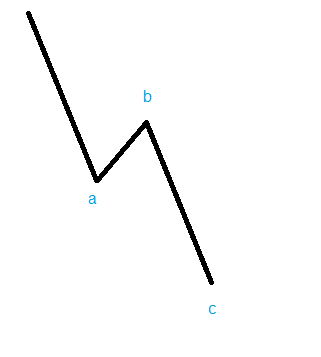
Above is the classic representation of a zigzag. As you can see, it is difficult to consider it an impulsive wave, for the simple reason that there is no extension.
However, the a-b-c structure has not one, but two impulsive waves, only of a lower degree. They make the price action within the zigzag even more bearish than in one single bearish impulsive move.
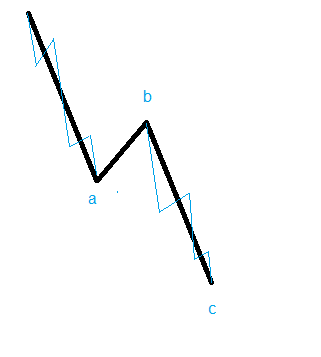
Plus, waves ‘a’ and ‘c’ have equal lengths, another clue that the move is corrective, not impulsive.
Further comparing the zigzag with the flat pattern, the c-wave’s length gives the type of the zigzag too. As such, three types of zigzags exist, based on the length of the c-wave:
1. Truncated zigzag.
A zigzag like this one rarely forms in Forex trading. For a zigzag to “truncate,” the c-wave ends before 61.8% of wave ‘a’. Therefore, the way to find out is to:
- Pick the Fibonacci Retracement tool from the MT4 platform
- Measure the length of wave ‘a’ from its start until its end
- Find out the 61.8% level
- Draw a trendline to measure the distance
- Project the distance from the end of the c-wave
If the c-wave ends before that level, the zigzag truncates. The implications are tremendous, because the price action following the truncated zigzag retraces the entire zigzag. Hence, the zigzag was a fake move.
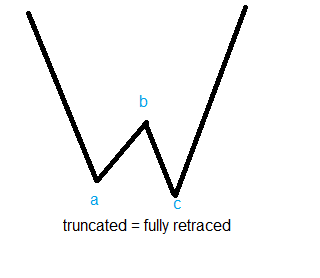
2. Elongated Zigzag
Another rare pattern, the elongated zigzag has the c-wave as the longest segment of the entire pattern. In other words, the impulsive wave that makes the c-wave is so strong, it trips all the possible stops it meets.
The minimum distance for the c-wave is 161.8% of wave ‘a’, and the same steps are necessary:
- Pick the Fibonacci Retracement tool from the MT4 platform
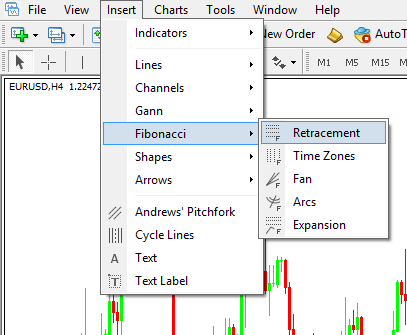
- Measure the length of wave a from its start until its end
- Find out the 61.8% level
- Draw a trendline to measure the distance
- Project the distance from the end of the c-wave
3. Normal zigzag
By far the most common zigzag type, the normal zigzag often appears in Forex trading. If we are to use percentages, this type of zigzag forms in over 80% of the cases. Therefore, I would be reluctant labeling a zigzag as elongated or truncated, only considering the fact that they don’t form that often.
Double and Triple Zigzags in Forex Trading
We already touched the subject of complex corrections within the Elliott Waves Theory, as it is the only way a triangle acts as a reversal pattern. Therefore, the notion of an x-wave as an intervening or connecting wave should be familiar.
But, x-waves appear in all kind of complex corrections. The most complex ones we’ll discuss later in other sections in the Trading Academy, but here it is worth mentioning that a zigzag is not that aggressive as a double zigzag. Or, a triple one.
If we compare the situations when a zigzag or a double or triple one forms, chances are we’ll see more double and triple patterns in Forex trading.
As such, the Forex market often forms not two, but four or even six consecutive impulsive waves. And, all this time, it makes little or no corrections.
The conditions for a double zigzag are:
- The first zigzag is normal or elongated
- A very small x-wave retraces the first zigzag
- The second zigzag is rarely elongated
- It channels very well
For a triple zigzag, we have:
- The first zigzag is normal or elongated
- A very small x-wave retraces the first zigzag
- The second zigzag is also normal or elongated
- The second x-wave takes more time than the first one
- The last zigzag is rarely elongated
- It channels very well
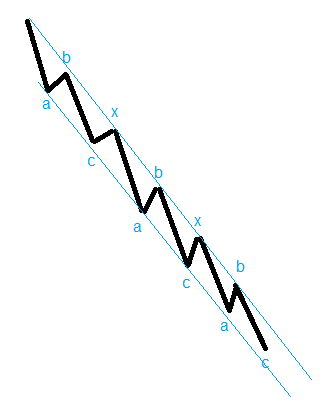
A triple zigzag looks like the image above, with the market forming six impulsive waves of a lower degree, connected by two intervening waves.
Conclusion
Traders that hear about the Elliott Waves Theory for the first time have the impression it is a simple approach to the market. In a way, it is, as the basic impulsive and corrective rules aren’t difficult to follow and understand.
However, to fully apply it in Forex trading, there is more to it than counting five swings and labeling three opposite swings. If you think zigzags are complicated, wait to see later in the Trading Academy what a running correction is, where elongated patterns form, and even how to identify tops and bottoms with the Elliott Theory.
But this is not a course about Elliott. It is a course that explains the impact the theory has in all markets, especially in Forex trading.
Nowadays, Forex trading is dominated by robots or trading algorithms that buy and sell thousands of trades per second. What strategy still works in front of such technologies?
The Elliott one works! Because even robots follow programs and rules established by humans, the pessimism and optimism in markets still exist. Hence, crowd behavior hasn’t disappeared in Forex trading.


